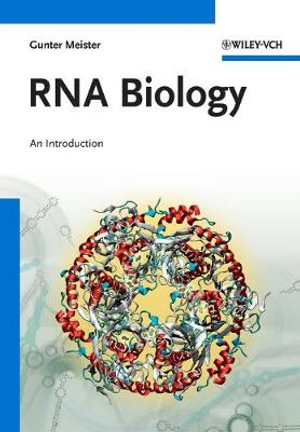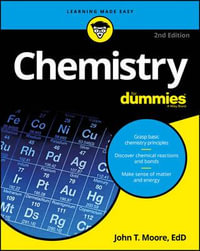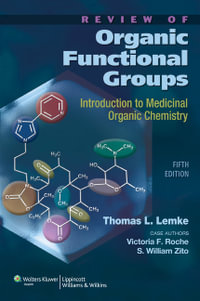
At a Glance
380 Pages
1.7 x 24.1 x 17.2
Paperback
Limited Stock Available
RRP $131.35
$123.75
or 4 interest-free payments of $30.94 with
orGunter Meister abandons the traditionalist treatment of nucleic acids found in most biochemistry and molecular biology texts, adopting instead a modern approach in both concept and scope. The text is divided into three parts, on mRNA, non-coding RNA, and RNomics, and the author addresses the traditional roles of RNA in the transmission and regulation of genetic information, as well as the recently discovered functions of small RNA species in pathogen defense, cell differentiation and higher-level genomic regulation.
All set to become the standard for teaching molecular science to biologists and biochemists.
Industry Reviews
biochemistry textbooks." (ChemMedChem, 2011)
"Meister (biochemistry, U. of Regensburg, Germany) covers RNA biology comprehensively without getting into mechanistic detail, to provide an introduction for undergraduate students of all life sciences. Chapter-end references point to fuller treatments for students who are interested." (Book News, 1 October 2011)
Preface xv
Part One mRNA Biology 1
1 Introduction 3
1.1 RNA Building Blocks 4
1.2 RNA Folding 6
1.3 The RNA World Hypothesis 10
1.4 Functions of RNA 11
1.5 Protein Classes that are Required for RNA Function 12
1.5.1 RNA Binding Proteins 12
1.5.1.1 Proteins that Interact with Single Stranded RNAs 12
1.5.1.2 Proteins that Interact with Double Stranded RNAs 14
1.5.2 RNA Helicases 14
References 15
2 Transcription of Pre-mRNAs 17
2.1 Structure and Organization of Protein Coding Genes 18
2.2 Transcription of Mrnas by Rna Polymerase II 20
2.2.1 Transcriptional Initiation of Protein Coding Genes 23
2.2.2 Regulation of Transcriptional Initiation of Rna Polymerase II 27
2.2.3 Transition from Preinitiation to Initiation and Promoter Clearance 27
2.2.4 Productive Elongation of mRNA Transcripts 29
2.2.4.1 The Nucleotide Addition Cycle (NAC) 29
2.2.4.2 Protein Factors that Influence Pol II Elongation 30
2.3 Transcriptional Termination of Pre-mRNAs 31
2.4 Transcription is Coupled to Other mRNA Maturation Steps 32
2.5 Summary 34
References 35
3 Capping of the Pre-mRNA 5 0 End 37
3.1 m 7 G-cap Structure 37
3.2 mRNA Capping Enzymes 39
3.2.1 RNA Triphosphatase 39
3.2.2 Guanylyltransferase 39
3.2.3 Guanine-N7-Methyltransferase 40
3.3 5 0 Capping is Coupled to Transcription 41
3.4 5 0 Cap Binding Proteins 41
3.5 Summary 42
References 43
4 3 0 End Processing of Pre-mRNAs 45
4.1 Polyadenylation Signals 46
4.2 Proteins Involved in 3 0 End Processing of Pre-mRNAs 47
4.2.1 Cleavage and Polyadenylation Specific Factor (CPSF) 47
4.2.2 Cleavage Stimulation Factor (CstF) 47
4.2.3 Mammalian Cleavage Factor I (CFI m) and II (CFII m) 48
4.2.4 The Poly(A) Polymerase (PAP) 49
4.2.5 Poly(A)-Binding Protein (PABP) 50
4.2.6 Symplekin 51
4.3 3 0 End Processing is Tightly Linked to Transcriptional Termination 51
4.4 Alternative Polyadenylation 51
4.5 Cytoplasmic Polyadenylation 53
4.6 3 0 End Processing of Histone mRNAs 54
4.7 Summary 56
References 57
5 Splicing of Eukaryotic Pre-mRNAs 59
5.1 Group I, II and III Introns 59
5.1.1 Group I Introns 59
5.1.2 Group II Introns 61
5.1.3 Group III Introns 61
5.2 The Mechanism of pre-mRNA Splicing 61
5.3 The Spliceosome 62
5.4 The U12-Dependent Minor Spliceosome 66
5.5 Coupling of Splicing with Transcription and 5 0 Capping 67
5.6 Alternative Splicing and the Complexity of Genomes 68
5.6.1 Mechanisms of Exon Inclusion into the Mature mRNA 69
5.6.2 Mechanism of Exon Exclusion from the Mature mRNA 70
5.7 Summary 70
5.8 Questions 71
References 72
6 mRNA Export from the Nucleus to the Cytoplasm 73
6.1 Nuclear Import and Nuclear Export 73
6.2 mRNA Export Receptors 75
6.3 Adaptors that Bridge mRNAs with Export Receptors 78
6.4 Mechanism of mRNA Export 78
6.5 Coupling of mRNP Export to Other Steps of mRNA Maturation 80
6.6 Summary 80
6.7 Questions 81
References 81
7 Translation 83
7.1 Amino Acids, mRNAs, tRNAs 83
7.1.1 mRNA 83
7.1.2 Amino Acids 84
7.1.3 Transfer RNAs (tRNAs) 86
7.1.4 Loading Amino Acids onto tRNAs 87
7.2 The Ribosome 89
7.3 The Mechanisms of Translation 90
7.3.1 Translation Initiation 90
7.3.1.1 Eukaryotes 90
7.3.1.2 Bacteria 93
7.3.1.3 Archaea 96
7.3.1.4 Internal Ribosome Entry Sites (IRESs) 96
7.3.2 Elongation 97
7.3.2.1 Polyribosomes 97
7.3.3 Termination 99
7.3.4 Recycling of the Ribosome 100
7.4 Translational Regulation 100
7.4.1 Regulation of Translation Initiation 100
7.4.2 Regulation of Translation Elongation and Termination 103
7.5 Coupling Translation with Other mRNA Maturation and Quality Control Steps 103
7.6 Summary 104
7.7 Questions 105
References 106
8 Deadenylation of mRNA 107
8.1 Deadenylating Enzymes 107
8.1.1 Poly(A) Nuclease 107
8.1.2 CCR4-NOT Complex 108
8.1.3 Poly(A) Ribonuclease 108
8.1.4 Other Deadenylases 110
8.2 Summary 111
8.3 Questions 111
References 112
9 mRNA Decapping 113
9.1 Decapping Enzymes are the Core of the mRNA Decapping Machinery 113
9.2 Scavenger Decapping Enzyme DcpS 115
9.3 Regulation of mRNA Decapping 115
9.3.1 Inhibitors of Decapping 115
9.3.2 Enhancers of Decapping 116
9.4 Intracellular Localization of mRNA Decapping 117
9.5 Summary 118
9.6 Questions 119
References 119
10 mRNA Decay Pathways 121
10.1 Deadenylation-Dependent mRNA Decay 122
10.1.1 The 5 0 to 3 0 Exoribonuclease Xrn 1 122
10.1.2 The Exosome 122
10.1.2.1 Structural Organization of the Exosome 125
10.1.2.2 Mechanism of Exosome-Mediated RNA Degradation 125
10.1.2.3 Regulation of Exosome Activity 126
10.2 Deadenylation-Independent mRNA Decay 127
10.3 Endoribonuclease-Mediated mRNA Decay 128
10.3.1 Eukaryotic Endoribonucleases 129
10.4 Regulation of mRNA Decay 131
10.5 RNA Degradation in Bacteria 131
10.6 Summary 133
10.7 Questions 134
References 135
11 mRNA Quality Control 137
11.1 Nuclear mRNA Quality Control Mechanisms 137
11.1.1 MRNP Retention at the Transcription Site 138
11.1.2 MRNP Quality Control at the Nuclear Pore Complex 138
11.2 Nonsense-Mediated mRNA Decay (NMD) 138
11.2.1 Protein Factors Required for NMD 139
11.2.1.1 UPF Proteins 139
11.2.1.2 The Exon–Exon–Junction Complex (EJC) and Nmd 140
11.2.1.3 SMG Proteins and the Phosphorylation of UPF 1 141
11.2.2 Mechanism of NMD in Mammals 142
11.2.3 Cytoplasmic Processing Bodies and NMD 143
11.2.4 Mechanism of NMD in Yeast and Flies 144
11.2.5 mRNA Degradation Pathways in NMD 146
11.3 Other mRNA Quality Control Pathways 146
11.3.1 Non-Stop mRNA Degradation 146
11.3.2 No-Go mRNA Decay (NGD) 148
11.4 Summary 148
11.5 Questions 149
References 149
Part Two Non-Coding RNA Biology 151
12 Ribosomal RNAs and the Biogenesis of Ribosomes 153
12.1 Genomic Organization of Ribosomal RNA Genes 153
12.1.1 Bacteria and Archaea 153
12.1.2 Eukaryotes 155
12.1.2.1 28S, 18S and 5.8S rRNAs 155
12.1.2.2 5S rRNA 156
12.2 Transcription of Ribosomal RNA Genes 157
12.2.1 RNA Polymerase I 157
12.2.1.1 Initiation of Pol I Transcription 158
12.2.1.2 Promoter Clearance, Transcript Elongation and Termination of Pol I Transcription 160
12.2.1.3 Regulation of RNA Polymerase I Transcription 161
12.2.2 RNA Polymerase III and the Transcription of the 5S rRNA 162
12.2.2.1 Pol III Promoters 163
12.2.2.2 Transcription Initiation and Elongation of Rna Polymerase III 165
12.2.2.3 Initiation of Type 3 Promoters 167
12.2.2.4 Termination and Re-Initiation 168
12.3 Maturation of rRNAs 169
12.3.1 Small Nucleolar RNAs are Required for Pre-rRNA Processing 170
12.4 Assembly of Ribosomal Subunits 172
12.5 Nuclear Export of Ribosomal Subunits 174
12.6 Modification, Structure and Function of rRNAs 175
12.7 Summary 178
12.8 Questions 179
References 180
13 Transfer RNAs 183
13.1 Genomic Organization and Transcription of tRNA Genes 183
13.2 Processing to Mature tRNAs 184
13.2.1 5 0 Maturation of tRNAs by the RNase P Enzyme Complex 184
13.2.2 3 0 End Maturation of tRNAs 186
13.2.3 tRNA Splicing 188
13.3 tRNA Modifications 191
13.4 Nuclear Export of tRNAs 193
13.5 Tertiary Structure of tRNAs 194
13.6 Summary 196
References 197
14 The 7SL RNA and the Signal Recognition Particle 199
14.1 Architecture of the SRP 199
14.1.1 The SRP RNA 199
14.1.2 Protein Components of the SRP 201
14.1.2.1 Eukaryotes 201
14.1.2.2 Archaea and Bacteria 203
14.2 SRP-Mediated Protein Translocation 204
14.3 Summary 206
References 208
15 Regulation of Transcription: the 7SK Small Nuclear RNA 209
15.1 Architecture of the 7SK snRNA 209
15.1.1 The 7SK snRNA 209
15.1.2 Protein Components of the 7SK snRNP 210
15.2 The 7SK snRNP Functions as Transcriptional Regulator 212
15.2.1 P-TEFb Function in Transcription 212
15.2.2 Repression of P-TEFb by the 7SK snRNP 214
15.3 Other Small Non-Coding RNAs that Interfere with Transcription 214
15.3.1 The 6S RNA in Bacteria 214
15.3.2 Alu, B1 and B2 Non-Coding RNAs in Mammals 215
15.4 Summary 215
References 216
16 Small Nucleolar RNAs 217
16.1 Genomic Organization and snoRNA Transcription 217
16.2 Box H/ACA snoRNAs 218
16.3 Box C/D snoRNAs 221
16.4 Maturation of Functional snoRNPs 223
16.5 Orphan snoRNAs 224
16.6 The Telomerase RNP 226
16.7 Summary 227
References 228
17 Spliceosomal Small Nuclear RNAs 229
17.1 Transcription and Maturation of Spliceosomal snRNAs 229
17.1.1 Transcription of Spliceosomal snRNAs 229
17.1.2 snRNA Maturation 230
17.1.3 SnRNA Export to the Cytoplasm 231
17.2 The Structure of UsnRNPs 232
17.2.1 Secondary Structure of Spliceosomal snRNAs 232
17.2.2 Protein Composition of UsnRNPs 233
17.2.2.1 The Sm/LSm Core Structure 233
17.2.2.2 UsnRNP-Specific Proteins 235
17.3 Assembly of Spliceosomal snRNPs 237
17.3.1 Cytoplasmic Assembly of the Sm Core Domain 237
17.3.2 Formation of the Tri-Methyl Guanine Cap 240
17.3.3 Import of Assembled UsnRNPs into the Nucleus 241
17.4 Summary 242
17.5 Questions 243
References 244
18 Small Non-Coding RNAs and the Mechanism of Gene Silencing 245
18.1 Short Interfering RNAs and the Mechanism of RNA Interference 245
18.2 Dicer 248
18.3 RNA-Dependent RNA Polymerases 248
18.4 Argonaute Proteins 251
18.5 microRNAs and the Regulation of Gene Expression 251
18.5.1 MiRNA Biogenesis 251
18.5.2 Non-Canonical miRNA Biogenesis Pathways 253
18.5.3 miRNA Functions 255
18.5.3.1 miRNAs Can Act as siRNAs 255
18.5.3.2 miRNAs Inhibit Translation 255
18.5.3.3 miRNAs Induce Deadenylation and mRNA Decay 256
18.6 PiRNAs and the Regulation of Mobile Genetic Elements in the Germ Line 257
18.6.1 Transposons as Driving Force Behind Evolution 258
18.6.2 PiRNAs Control Transposon Expression 259
18.7 Small RNAs with Functions in Chromatin Regulation 261
18.8 The CRISPR System – A Bacterial and Archaeal Defense Mechanism 263
18.8.1 The CRISPR Locus 263
18.8.2 Acquisition of CRISPR-Mediated Resistance 264
18.8.3 Mechanism of CRISPR Activity 265
18.9 Summary 266
References 269
19 Long Non-Coding RNAs 271
19.1 The XIST Non-Coding RNA and X Chromosome Inactivation 271
19.1.1 The X-Chromosome Inactivation Center (XIC) 272
19.1.2 the Xist Non-coding Rna and the Mechanism of X Inactivation 272
19.1.3 Regulation of XIST Function 274
19.2 Dosage Compensation in Flies 275
19.3 Non-Coding RNAs and the Regulation of Imprinting 276
19.4 The Regulation of HOX Genes by Long Non-Coding RNAs 278
19.5 Long non-Coding RNAs are Common in Complex Genomes 278
19.6 Summary 278
References 280
20 RNA Editing 281
20.1 RNA Editing by U Insertions or Deletions 281
20.1.1 Mechanisms of U Insertions or Deletions 282
20.2 RNA Editing by Base Modification 283
20.2.1 c to U conversion 284
20.2.2 Adenine to Inosine Editing 286
20.2.2.1 Adenosine Deaminase Acting on RNA 287
20.2.2.2 Editing Site Selectivity 288
20.2.2.3 Biological Consequences of A to I Conversions 288
20.3 Summary 290
References 291
21 Ribozymes – Catalytic RNA Molecules 293
21.1 Identification of Catalytic RNAs 293
21.2 Mechanisms and Secondary Structures of Different Ribozymes 294
21.2.1 Group I Introns 294
21.2.2 RNase P 295
21.2.3 The Diels–Alderase Ribozyme 296
21.2.4 Hammerhead Ribozymes 298
21.2.5 The glmS Ribozyme 298
21.3 Summary 300
References 301
22 Riboswitches and RNA Sensors 303
22.1 Mechanisms of Riboswitch Function 303
22.2 Riboswitch Structures 305
22.3 RNA Thermometers 305
22.4 Summary 307
References 308
23 RNomics 309
23.1 ‘‘Omics’’ Approaches 309
23.2 Experimental RNA Profiling Strategies 310
23.2.1 Northern Blotting 310
23.2.2 Microarray 311
23.2.3 Quantitative PCR 313
23.2.4 RNA Fluorescent In Situ Hybridization 314
23.2.5 Next Generation Sequencing 314
23.3 RNA Biology and the Complexity of Genomes 315
23.4 Summary 315
References 318
Appendix: Answers to Questions 319
Index 355
ISBN: 9783527322787
ISBN-10: 3527322787
Published: 6th January 2011
Format: Paperback
Language: English
Number of Pages: 380
Audience: Professional and Scholarly
Publisher: Wiley-VCH
Country of Publication: DE
Edition Number: 1
Dimensions (cm): 1.7 x 24.1 x 17.2
Weight (kg): 0.74
Shipping
| Standard Shipping | Express Shipping | |
|---|---|---|
| Metro postcodes: | $9.99 | $14.95 |
| Regional postcodes: | $9.99 | $14.95 |
| Rural postcodes: | $9.99 | $14.95 |
How to return your order
At Booktopia, we offer hassle-free returns in accordance with our returns policy. If you wish to return an item, please get in touch with Booktopia Customer Care.
Additional postage charges may be applicable.
Defective items
If there is a problem with any of the items received for your order then the Booktopia Customer Care team is ready to assist you.
For more info please visit our Help Centre.























